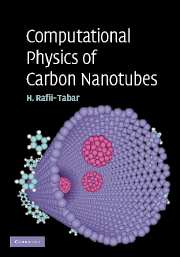11 - Modelling the thermal properties of carbon nanotubes
Published online by Cambridge University Press: 29 September 2009
Summary
Carbon nanotubes will form the essential components in all sorts of functional devices, from nanoscale transistors to nanofluidic devices and functionalised array medical nanosensors, to name but a few. Besides their mechanical and electronic properties, it is also very important to know their thermal properties and thermal performances. In contrast to the mechanical, electronic and storage properties of nanotubes, for which a rather significant number of modelling and experimental studies have been carried out, the investigations into the thermal properties of nanotubes have been rather scant. Measurements of the specific heat and thermal conductivity of microscopic structures, such as mats covered with compressed ropes of carbon composed of hundreds of nanotubes, have been made, providing valuable information on the ensemble-average thermal properties of these bulk-phase materials, rather than on individual nanotubes.
The measurement of the thermal conductivity of nanotubes, like the measurement of their other properties, is subject to a degree of uncertainty owing to the impurities that are likely to be present in the composition of synthesised nanotubes. For example, the MWCNTs grown by the chemical vapour deposition (CVD) technique at temperatures as low as T ∼ 600 K are not perfect, and this is borne out by the fact that their thermal and electrical conductivities are two orders of magnitude lower than those of perfect crystalline graphite at room temperature.
- Type
- Chapter
- Information
- Computational Physics of Carbon Nanotubes , pp. 450 - 476Publisher: Cambridge University PressPrint publication year: 2007



